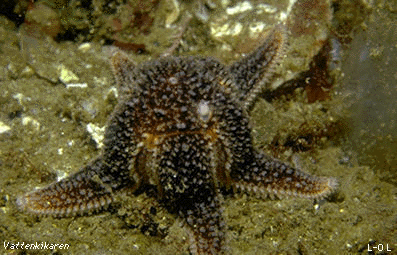|

Environment
|
|
More about the starfish
Environment
The starfish is common all along the Swedish
west coast. It is found on rocky and stoney substrate as well as on soft
bottoms, notably on mussel and oyster banks. Mobility is attained by a
unique hydro-vascular system of tube-feet that enable the starfish to
move at speeds of between 3-5 metres an hour.
What it eats
The starfish is commonly known for its
ability to open large mussels. To open a mussel the starfish places itself
over the mussel, rather like an umbrella and places a great number of
tube-feet on the two shell halves. An adult starfish using this technique
can exert a traction force of 4 kg. It was thought that the starfish secreted
a substance that paralysed the mussel, but it appears that traction is
enough to open the mussel. It is enough that the shell is opened 1 mm
for the starfish to get its stomach into the mussel shell and come into
contact with the mussels softer parts, and accordingly break it down.
Can eat alot at one time
Because the starfish
everts its stomach and encompasses its prey when it eats, it
is able to digest rather large prey. It is able to prey on
organisms that have a diameter equal to the length of its
arm.
The starfish has the ability to smell its prey over long
distances. A young starfish (radius 3,5 mm) that had recently fallen to
the bottom, ate during its first 6 days, 56 small mussels (1,5-3,5 mm
long) per day, which equals about 25-30 % of its own weight. As the starfish
gets older, its consumption decreases, adults eat about 3-4 % of their
body weight daily. It is the young that are most gluttonous and appear
in large numbers. During the winter, consumption decreases markedly, and
ceases totally at 2-3 °C.

Common starfish eating.
|
|
Page
1 of 3
|

|
|